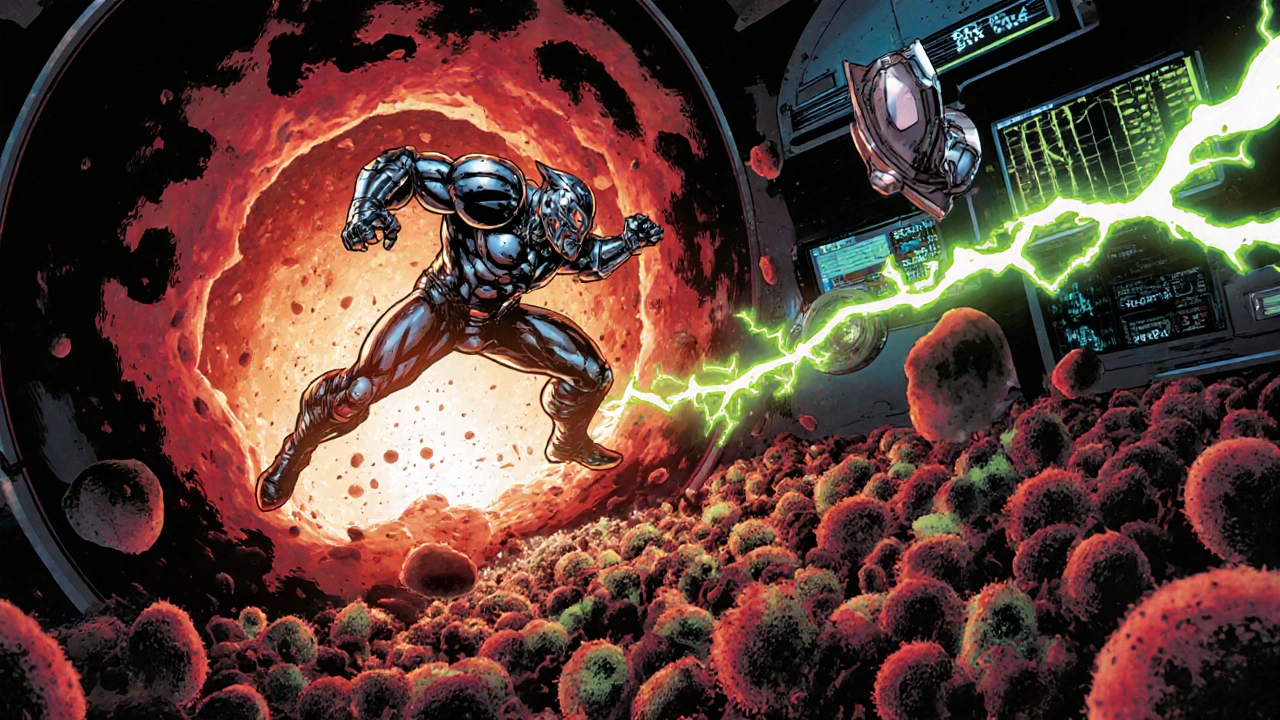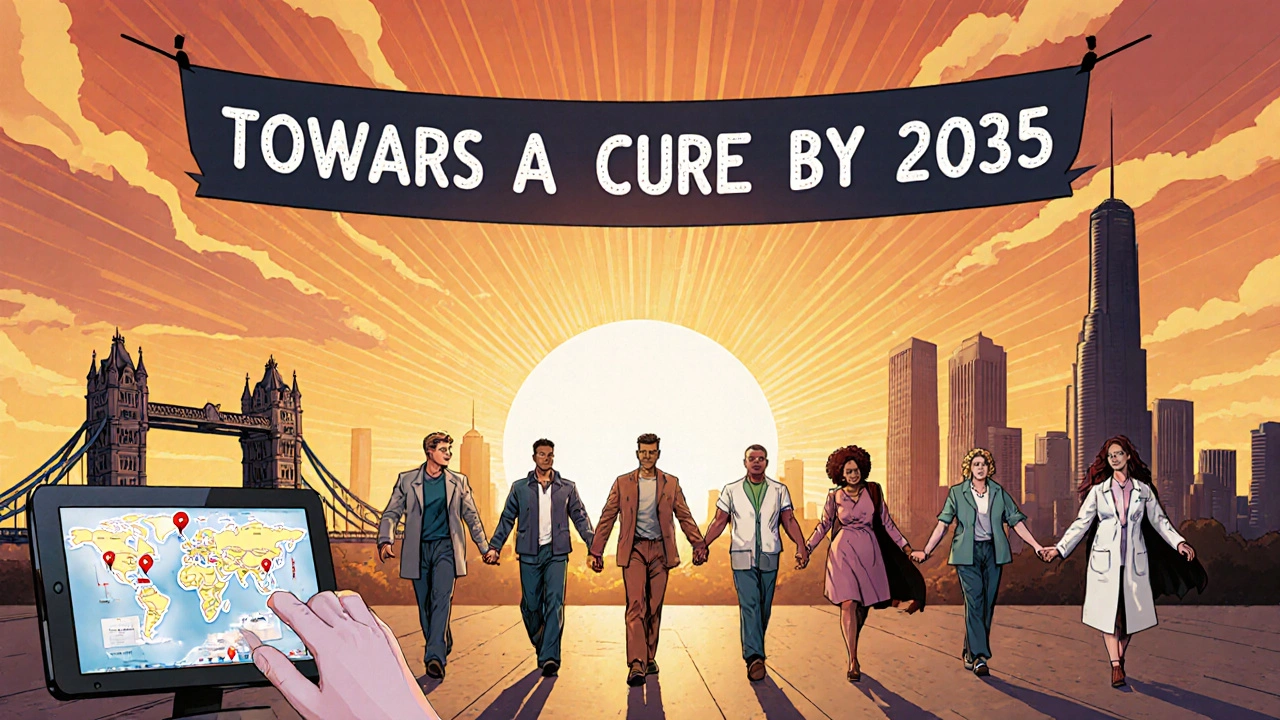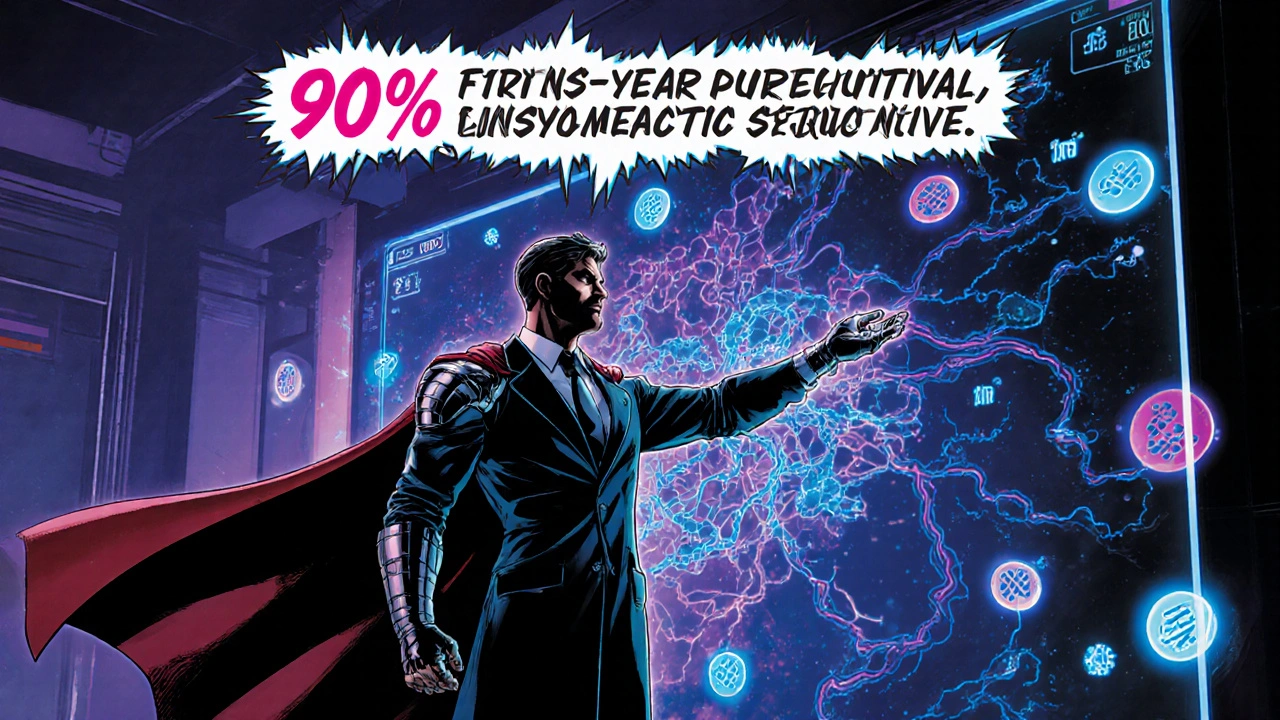Lymphoma Treatment Comparison Tool
Compare the latest lymphoma treatment options based on your specific subtype and needs. This tool uses data from the 2025 treatment guidelines and clinical studies.
Filter Treatment Options
Standard Treatment Comparison (2025)
Standard Chemo-immunotherapy (R-CHOP)
Mechanism: DNA damage + CD20 targeting
Response Rate: 60-70%
Administration: IV infusion, 6-8 cycles
Best for aggressive NHL subtypes
CAR-T Therapy
Mechanism: Engineered T-cells recognize CD19
Response Rate: 80-90%
Administration: Single infusion after leukapheresis
For relapsed large-B-cell, mantle-cell, follicular lymphoma
Bispecific Antibody
Mechanism: Dual binding to CD3 and CD20
Response Rate: 65-75%
Administration: Weekly IV, then maintenance
For relapsed/refractory NHL
PD-1 Checkpoint Inhibitors
Mechanism: Blocks PD-1/PD-L1 interaction
Response Rate: 70-80%
Administration: IV every 2-3 weeks
For relapsed classic Hodgkin lymphoma
Targeted Small-Molecule Inhibitors
Mechanism: Inhibits Bruton's tyrosine kinase
Response Rate: 55-65%
Administration: Oral daily
For mantle-cell, CLL/SLL
Important Note: Treatment options should always be discussed with your oncologist. This tool is for general informational purposes only and does not constitute medical advice.
In 2025, five‑year survival for certain lymphoma subtypes tops 90%, a jump from just 70% a decade ago. That surge isn’t luck-it’s the result of a wave of scientific breakthroughs that are reshaping how doctors fight this blood cancer.
Key Takeaways
- Lymphoma classifications and basic biology are now routinely mapped with genetic profiling.
- CAR‑T cell therapy and bispecific antibodies have become standard options for relapsed disease.
- Precision‑medicine trials are testing dozens of targeted agents, with several showing >70% response rates.
- Patients can access cutting‑edge treatments through expanded access programs and specialty centers.
- Experts predict a functional cure for many low‑grade lymphomas within the next 10‑15 years.
Understanding Lymphoma
Lymphoma is a group of cancers that start in the lymphatic system, the body’s fluid‑draining network. It splits into two main families: Hodgkin lymphoma (HL) and non‑Hodgkin lymphoma (NHL). Each family contains dozens of subtypes distinguished by cell origin, genetic mutations, and growth patterns.
Modern diagnostics look beyond the microscope. Next‑generation sequencing panels now identify driver mutations-like MYD88, EZH2, or TP53-in more than 80% of cases. Those genetic clues guide therapy choices and help predict prognosis.

Recent Treatment Breakthroughs
For years, the backbone of lymphoma care was chemotherapy combined with radiation. That approach still works for early‑stage disease, but the real game‑changers arrived after 2017.
CAR‑T therapy (chimeric antigen receptor T‑cells) turned a patient’s own immune cells into living missiles that hunt cancer. In 2022 the FDA approved axicabtagene ciloleucel for large‑B‑cell lymphoma, and by 2025 three additional CAR‑T products cover mantle‑cell and follicular lymphomas. Real‑world studies report overall response rates (ORR) of 80‑90% and durable remissions lasting five years or more.
Bispecific antibodies are another hot‑topic. These engineered proteins bind both a T‑cell (via CD3) and a tumor antigen (usually CD20). Agents like mosunetuzumab and glofitamab entered practice in 2023, offering outpatient infusion schedules and fewer cytokine‑release events than CAR‑T. Early data show ORR near 70% for patients who failed multiple prior lines.
Checkpoint inhibitors, once the realm of melanoma, now have a firm foothold in classic Hodgkin lymphoma. Drugs targeting PD‑1 (nivolumab, pembrolizumab) achieve 70‑80% response in relapsed HL, and combination regimens with chemotherapy boost first‑line cure rates.
Targeted small‑molecule inhibitors-such as ibrutinib (BTK inhibitor) for mantle‑cell lymphoma and idelalisib (PI3K‑δ inhibitor) for follicular lymphoma-provide oral options with manageable toxicity. Their use has expanded to frontline settings based on phase‑III trial outcomes released this year.
Emerging Therapies on the Horizon
Even with these successes, researchers keep pushing. A few promising directions include:
- Bispecific T‑cell engagers (BiTEs) that target novel antigens like CD30 and CD79b, aiming to treat rare subtypes.
- Next‑generation CAR‑T cells engineered to resist exhaustion and secrete cytokines, currently in phase‑I trials for diffuse large B‑cell lymphoma (DLBCL).
- Epigenetic modulators, such as EZH2 inhibitors, which reverse abnormal gene silencing in follicular lymphoma.
- RNA‑based vaccines that teach the immune system to recognize lymphoma‑specific neoantigens.
- Combination regimens that pair targeted agents with immunotherapies, leveraging synergy observed in early studies.
All of these pipelines are backed by a growing network of clinical trials-more than 1,200 open studies listed on ClinicalTrials.gov for lymphoma alone in 2025.
How Patients Can Access New Options
Getting a cutting‑edge treatment isn’t automatic. Here’s a practical roadmap:
- Ask your oncologist for a comprehensive genetic profile. Most major cancer centers offer next‑generation sequencing panels covered by insurance.
- Identify a specialty lymphoma center-such as the Royal Marsden in London or the MD Anderson Cancer Center-that runs the trials you’re eligible for.
- If a therapy is still investigational, explore expanded‑access (compassionate‑use) programs. Manufacturers often grant temporary use for patients who meet strict criteria.
- Discuss the role of hematopoietic stem cell transplant. For aggressive NHL, autologous transplant remains a curative intent after chemo, especially when paired with post‑transplant maintenance.
- Stay informed about emerging biomarkers. Tests for circulating tumor DNA can monitor disease in real‑time and signal early relapse.
Patient advocacy groups, like Lymphoma Action (UK) and the Lymphoma Research Foundation (US), maintain up‑to‑date trial databases and provide navigation assistance free of charge.

Outlook for a Cure
When experts talk about “cure,” they usually mean long‑term, treatment‑free survival. For indolent lymphomas, that benchmark is already within reach for a sizable minority, thanks to the arsenal described above.
Projections from the National Cancer Institute suggest that by 2035, overall survival for all lymphoma subtypes will exceed 85%, with many patients achieving drug‑free remission. The key drivers are threefold: precise molecular classification, immune‑based therapies that eradicate residual disease, and real‑world data that refine treatment sequencing.
While a universal cure for every lymphoma form may still be years away, the trajectory is clear-more patients will live normal lives without chronic therapy.
Treatment Comparison at a Glance
| Therapy | Mechanism | Approved Indications (2025) | Typical Response Rate | Administration |
|---|---|---|---|---|
| Standard Chemo‑immunotherapy (e.g., R‑CHOP) | DNA damage + CD20 targeting | Most aggressive NHLs | 60‑70% | IV infusion, 6‑8 cycles |
| CAR‑T therapy | Engineered T‑cells recognize CD19 | Large‑B‑cell, mantle‑cell, follicular (relapsed) | 80‑90% | Single infusion after leukapheresis |
| Bispecific Antibody | Dual binding to CD3 and CD20 | Relapsed/refractory NHL | 65‑75% | Weekly IV, then maintenance |
| PD‑1 Checkpoint Inhibitor | Blocks PD‑1/PD‑L1 interaction | Relapsed classic Hodgkin lymphoma | 70‑80% | IV every 2‑3 weeks |
| Targeted Small‑Molecule (e.g., BTK inhibitor) | Inhibits Bruton's tyrosine kinase | Mantle‑cell, CLL/SLL | 55‑65% | Oral daily |
Frequently Asked Questions
What is the difference between Hodgkin and non‑Hodgkin lymphoma?
Hodgkin lymphoma features Reed‑Sternberg cells and often spreads in a predictable pattern. Non‑Hodgkin lymphoma comprises many subtypes that arise from different lymphocytes and have varied growth rates.
Is CAR‑T therapy safe for older patients?
Recent studies show patients up to 80 years old can tolerate CAR‑T with proper monitoring. Risks like cytokine release syndrome are lower with newer constructs, but a thorough cardiac and pulmonary assessment is still required.
How can I find a clinical trial for my lymphoma type?
Start at ClinicalTrials.gov, filter by cancer type, phase, and location. Your oncologist can also check the trial portals of major cancer centers, which often have dedicated nurse navigators.
Do these new treatments replace chemotherapy?
Not yet. Many protocols still combine new agents with chemo to achieve deep remission. Over time, as data accumulate, some regimens may become chemo‑free, especially for low‑grade disease.
What does "cure" mean for lymphoma patients?
In clinical terms, a cure means the patient remains disease‑free for at least five years without further therapy. For many indolent lymphomas, that milestone is now being reached thanks to targeted and immune‑based treatments.
With each new drug, diagnostic tool, and trial, the landscape keeps shifting toward a future where lymphoma is no longer a death sentence. The promise of a cure is no longer a distant dream-it’s becoming a realistic goal for millions.

Carlise Pretorius
September 13, 2025
These new drugs sound promosing lol
Johnson Elijah
September 14, 2025
Wow, the pace of innovation in lymphoma care is genuinely inspiring! 🚀 The fact that CAR‑T and bispecifics are now standard options is a huge win for patients everywhere. 🌍 Keep the hope flowing, community! 💪
alex cristobal roque
September 16, 2025
Alright, let me break down what’s really happening with these 2025 advances because there’s a lot to unpack. First off, the genetic profiling you see everywhere now is not just a buzzword – it actually guides us to the right target, whether it’s a BTK inhibitor for mantle‑cell or an EZH2 inhibitor for follicular lymphoma. Second, CAR‑T therapy has moved from a niche to a more mainstream option, with three products covering large‑B‑cell, mantle‑cell, and even some follicular cases, and the real‑world data are showing ORRs in the 80‑90% range, which is insane compared to the old chemo numbers. Third, bispecific antibodies like mosunetuzumab are giving us outpatient‑friendly regimens that still pack a punch-response rates are hovering around 70% and the cytokine release syndrome rates are way lower now that we’ve learned how to manage them. Fourth, checkpoint inhibitors, especially PD‑1 blockers, are no longer just for Hodgkin; they’re being paired with chemo in first‑line protocols for certain NHL subtypes, boosting cure rates dramatically. Fifth, the oral small‑molecule world is exploding – think ibrutinib, acalabrutinib, and now newer BTK degraders that are less toxic and can be combined with immunotherapy. Sixth, trial enrollment is crucial – there are over 1,200 active lymphoma studies, and many centers now have dedicated navigators to help patients get on board without the usual bureaucratic hassle. Seventh, stem‑cell transplant is still a cornerstone for aggressive disease, but now we’re seeing post‑transplant maintenance with targeted agents to keep the disease at bay. Eighth, real‑world evidence is feeding back into guidelines faster than ever, meaning the standard of care is updating almost yearly. Ninth, the side‑effect profile of these newer agents is generally milder, which translates into better quality of life for patients who might otherwise be stuck on months of chemo. Tenth, the cost is still a barrier, but there are expanded access programs and insurance reforms that are slowly improving accessibility. Eleventh, patient advocacy groups are playing a bigger role in education and trial matching, which is a game‑changer for early detection of options. Twelfth, the concept of a functional cure is becoming realistic for many low‑grade lymphomas – we’re talking drug‑free remission for years. Thirteenth, the integration of circulating tumor DNA monitoring lets us catch relapses early and intervene before symptoms flare. Fourteenth, the collaborative effort between pharma, academia, and biotech is accelerating the pipeline, so we can expect even more novel agents in the next few years. Finally, the overall outlook is that by 2035, survival across the board should exceed 85%, and for many patients, lymphoma will be a chronic condition they can manage or even put behind them entirely. That’s a massive shift from where we were a decade ago.
Bridget Dunning
September 17, 2025
Colleagues, the therapeutic landscape delineated herein epitomises a paradigm shift predicated upon molecular stratification and immunologic modulation. The advent of chimeric antigen receptor T‑cell platforms, alongside bispecific T‑cell engagers, augments cytotoxic precision whilst mitigating off‑target sequelae. Moreover, checkpoint blockade, once relegated to melanoma, now substantively enhances remission durability in classical Hodgkin lymphoma. It is incumbent upon us, as a multidisciplinary consortium, to integrate these modalities within evidence‑based algorithms, ensuring optimal sequencing and combinatorial synergies. I commend the authors for their comprehensive synthesis of contemporary data.
Gary Smith
September 18, 2025
Indeed, the data are compelling!!! However, one must not overlook the broader implications!!! The sheer scale of investment from pharmaceutical conglomerates is a testament to the strategic priority placed on oncology!!! Yet, transparency regarding trial outcomes remains insufficient!!! We should demand greater openness!!!
Dominic Dale
September 19, 2025
Look, the pharma giants aren't just innovating for the sake of science-they're engineering a dependency network that funnels billions into their pockets while the public remains oblivious. Every new "breakthrough" comes with hidden clauses, data‑suppression agreements, and a cascade of off‑label marketing that steers physicians toward profit‑driven protocols. The so‑called "expanded access" programs are PR stunts that mask the fact that most patients still can't afford these cutting‑edge therapies without crippling insurance premiums. Meanwhile, the regulatory bodies are co‑opted, turning safety oversight into a rubber‑stamp process. It's a coordinated effort to keep the masses reliant on ever‑more expensive treatments while the cure remains out of reach.
christopher werner
September 20, 2025
If you're looking into the latest options, a good first step is to ask your oncologist about getting a comprehensive genetic panel. Many major centers cover the cost, and it can open doors to targeted trials that match your specific mutations.
Patrick Price
September 21, 2025
Yo, just wanted to add that you can also check out sites like clinicaltrials.gov and filter by your specific subtype. Sometimes they list understudied therapies that aren't mainstream yet but might be worth a look.
Achint Patel
September 22, 2025
Consider the paradox: as we dissect the molecular lattice of lymphoma, we also confront the existential fragility of the self, where each therapeutic vector becomes a mirror reflecting the dialectic between mortality and agency.
Lilly Merrill
September 23, 2025
Just reading through all this makes me feel optimistic about where treatment is heading. It’s good to know there are so many avenues to explore if you or someone you know needs help.
Charlie Martin
September 24, 2025
Thanks for the perspective; it’s reassuring to see the community sharing resources without any extra flair.